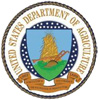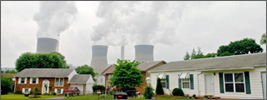Catalog of Environmental Programs 2012
| Federal agencies that contribute to EPA's environmental goals, and how they make a difference. |
the Catalog |
All Programs |
Programs by EPA Strategic Goal 1. Climate Change and Improving Air Quality 2. Protecting America's Waters 3. Cleaning Up and Sustainable Development 4. Safety of Chemicals and Preventing Pollution |
Programs by Agency AID, ARC, CNCS, CPSC, CSB, DHS, DOC, DOD, DOE, DOI, DOJ, DOL, DOS, DOT, ED, FHFA, GSA, HHS, HUD, NASA, NRC, NSF, OSTP, SBA, TVA, USDA, USPS, USTR, VA |

Department of Agriculture |

EPA Goal 3: Cleaning Up Communities and Advancing Sustainable Development |
Conservation Reserve Program (CRP) and CREP
Purpose
The CRP is a voluntary program for agricultural landowners. Through CRP, you can receive annual rental
payments and cost-share assistance to establish long-term, resource conserving covers on eligible
farmland.
CRP protects millions of acres of American topsoil from erosion and is designed to safeguard the
Nation's natural resources. By reducing water runoff and sedimentation, CRP protects groundwater
and helps improve the condition of lakes, rivers, ponds, and streams. Acreage enrolled in the CRP
is planted to resource-conserving vegetative covers, making the program a major contributor to
increased wildlife populations in many parts of the country.
The Conservation Reserve Enhancement Program (CREP) is a voluntary land retirement program
that helps agricultural producers protect environmentally sensitive land, decrease erosion,
restore wildlife habitat, and safeguard ground and surface water.
The program is a partnership among producers; tribal, state, and federal governments; and,
in some cases, private groups. CREP is an offshoot of the Conservation Reserve Program (CRP).
Source(s) of Information
1. USDA: Conservation Programs
2. USDA: Conservation Reserve Enhancement Program
Related EPA Program(s)
Research: Sustainable Communities:
In FY 2012, EPA is realigning and integrating the following individual Research program/projects into a new integrated, Sustainable
and Healthy Communities (SHC) research program/project:
- Human Health research
- Ecosystems Services research
- Land Protection and Preservation research
- Pesticides and Toxics research
- Sustainability research
- Fellowships
The integrated research approach will look at problems from a systems perspective, and help develop sustainable
solutions by adding a transformative component to EPA’s existing air research portfolio. The Sustainable and Healthy
Community Research Program (SHCRP) will, develop and conduct research leveraging the diverse capabilities of
in-house scientists and engineers, and bridge traditional scientific disciplines. Research plans will incorporate
input from external stakeholders such as federal, state and local government agencies, non-governmental
organizations, industry, and communities affected by environmental problems.
The main action areas of the new SHCRP will be:
• Working with communities to develop comprehensive approaches to become more sustainable, by improving the
sustainability of buildings, infrastructure, regional planning/zoning, transportation, waste management, and site revitalization;
• Developing decision analysis methods, tools, models, data and metrics that support community sustainability; and
• Meet EPA’s regulatory requirements
Targeting high priority Agency research needs, such as contaminated site management and restoration, support for
nitrogen regulation, environmental justice, children's health, the report on the environment and fellowships.
Authorizing Legislation
• Brownfield’s Revitalization and Environmental Restoration Act, Subtitle A. Section 211
• CERCLA, Section 105(a) (4) and Section 115 read together with Executive Order 12580, 42. U.S.C. 9605 (a) (4) and 9615
• CERCLA 104(i) and 42 U.S.C. 9660 – Sec. 311 (c) 42 U.S.C. 9602 - Section 102, Section 105(a) (4) and Section 115 read together with Executive Order 12580, 42. U.S.C. 9605 (a) (4) and 9615, Section 311, 42 U.S.C 9604 (i) (1)
• CERCLA 104(i), 42 U.S.C 9604 (i) (1), CERCLA, Section 105(a) (4) and Section 115 read together with Executive Order 12580, 42. U.S.C. 9605 (a) (4) and 9615, Comprehensive Environmental Response, Compensation, and Liability Act (CERCLA) 42 U.S.C. 9604 – Sec. 104 (i) and 42 U.S.C. 9660 – Sec. 311 (c) 42 U.S.C. 9602 - Section 102, Comprehensive Environmental Response, Compensation and Liability Act, Section 311. 42 USC 9660, Comprehensive Environmental Response, Compensation and Liability Act (CERCLA), Section 311, 42 U.S.C 9660, Comprehensive Environmental Response, Compensation, and Liability Act (CERCLA) 42 U.S.C. 9604 – Sec. 104 (i) and 42 U.S.C. 9660 – Sec. 311 (c) 42 U.S.C. 9602 - Section 102, Comprehensive Environmental Response, Compensation and Liability Act, Section 311. 42 USC 9660, Oil Pollution Act Title VII – Sec. 7001, Clean Air Act (CAA), 42 U.S.C. 7403, 7404
• Clean Air Act (CAA), 42 U.S.C. Sec. 103, 104 & 154
• Clean Water Act (CWA), 33 U.S.C. Sec. 101-121
• Energy Policy Act of 2005,
• Environmental Research, Development and Demonstration Authorization Act (ERDDA), 42 U.S.C. 4361-4370
• Federal Insecticide, Fungicide, and Rodenticide Act (FIFRA), 7 U.S.C. 136;
• Federal Food and Drug Cosmetic Act (FFDCA),7 U.S.C , 21 U.S.C.
• Food Drug Cosmetic Act (FFDCA), Quality Protection Act (FQPA)
• Global Change Research Act (USGCRA), 15 U.S.C. 2921
• Hazardous and Solid Waste Amendments of 1984, Oil Pollution Act (OPA), Title VII Sec. 7001, Resource Conservation and Recovery Act (RCRA) 42 U.S.C. 6981
• Resource Conservation and Recovery Act, Subtitle I, Leaking Underground Storage Tank (LUST) Trust Fund, Safe Drinking Water Act, Section 1442. 42 U.S.C. 300j-1, Solid Waste and Disposal Act, Section 8001, as amended
• Solid Waste Disposal Act (SWDA), 42 U.S.C. 6901 - Section 1002, 42U.S.C. 6905 - Section 1006, Superfund Amendments Reauthorization Act 42 U.S.C. 7401 – Sec. 209 (a) and Sec. 403 (a,b);
• Toxic Substances Control Act (TSCA), 15 U.S.C., Section 2609
Other Programs under Goal 3
Other Programs from USDA
Top of page


